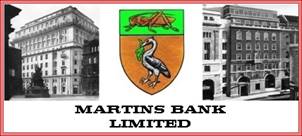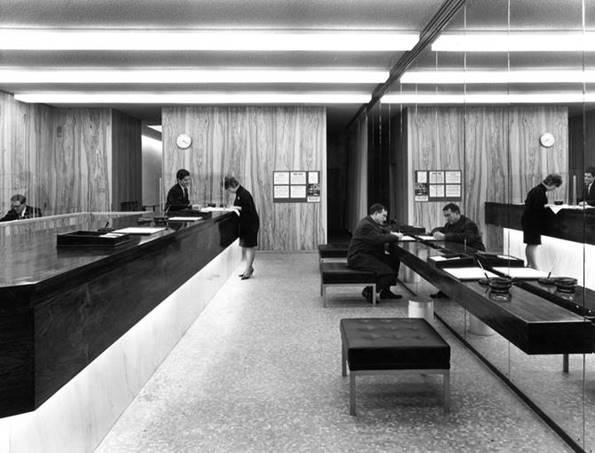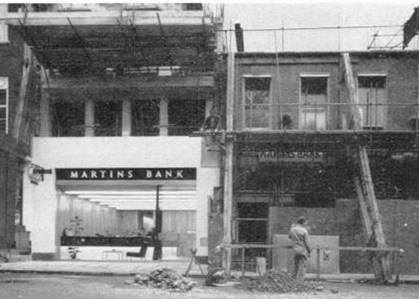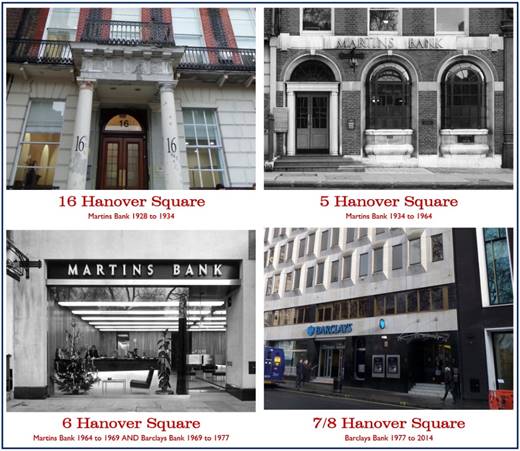|




Perhaps it would be churlish to
complain, sometimes the old simply has to make way for the new, and if there is
a plus side, perhaps it is that on the inside at least, Martins Bank’s new
Branch at No 6 Hanover Square does promise the brightest and most spacious
surroundings in which to transact business.
If the idea is to attract young professionals and what are referred to
as “modern marrieds” to open bank accounts and deposit their salaries, this
design might just do it… It does, however seem to be that little bit
futuristic for 1964, a kind of warning shot across the bows that all in the
world of architecture is not at peace with itself. Yet in Post-War britain, where slums were
still being cleared nearly two decades after the end of hostilities, such a
vision of concrete, glass and metal must have seemed so appealing to almost
everyone tired of dark wood and forbidding stone. Some might have foreseen
today’s backlash against all that is square, rectangular, box-like, dead
behind the eyes and so on, but at the time, Architects were the new gods,
first drawing, then building tomorrow as if it was a kind of conjuring trick.
The Bank’s building at 5
Hanover Square, although attractive, was extremely sick and in dire need of
attention, but just what were the events that made moving to premises
situated only next door so fraught with diffulty and danger? Read on, as this article from Martins Bank
Magazine’s Winter 1964 Edition shows us all how to achieve:
|

In Service: 1964 until 4 April 1977
 

Branch Images © Barclays Ref 0033-0256


|
|
Some
lively steps in the Hanover Square Dance…


  in
recent years there has been a noticeable increase in the number of Head
Office circulars advising new addresses for existing branches and, whether
the changes are due to progress, expansion, modernisation, or town-planning,
the transfer from the old office to the new, apart from petty annoyances, is
usually effected without undue trouble. A
move to new premises next door would, naturally, seem the easiest to
accomplish for one merely has to continue until the new premises are ready
when, in a week-end, cash, cabinets, securities—well, many of us have been through it and there is no point
dwelling on it. Hanover Square branch in London should have provided just
such a simple example, for Number 5 (the old office) is next door to Number 6
(the new). Perhaps you remember altering the number in the branch address
book in October? But did you know that some six months earlier No 5 made a
determined attempt at moving into No 6? No? Well this is the story. Early this year No 6 had, as the
photograph shows, become a hole in the ground with the flank of No 5
supported by a network of steel tubing. The staff at No 5 were, however,
becoming suspicious that cracks appearing in the plaster were tending to
widen and so 'tell-tale' strips had been stuck across these to see if this
really was so. in
recent years there has been a noticeable increase in the number of Head
Office circulars advising new addresses for existing branches and, whether
the changes are due to progress, expansion, modernisation, or town-planning,
the transfer from the old office to the new, apart from petty annoyances, is
usually effected without undue trouble. A
move to new premises next door would, naturally, seem the easiest to
accomplish for one merely has to continue until the new premises are ready
when, in a week-end, cash, cabinets, securities—well, many of us have been through it and there is no point
dwelling on it. Hanover Square branch in London should have provided just
such a simple example, for Number 5 (the old office) is next door to Number 6
(the new). Perhaps you remember altering the number in the branch address
book in October? But did you know that some six months earlier No 5 made a
determined attempt at moving into No 6? No? Well this is the story. Early this year No 6 had, as the
photograph shows, become a hole in the ground with the flank of No 5
supported by a network of steel tubing. The staff at No 5 were, however,
becoming suspicious that cracks appearing in the plaster were tending to
widen and so 'tell-tale' strips had been stuck across these to see if this
really was so.

 One morning some mortar fell precariously near Mr E. G. Vodden,
the branch messenger, as he entered the front door. Looking up he saw large
cracks in the front wall which appeared to be bulging more than might be
expected even of a building about 200 years old. Later in the morning a
member of the staff was fascinated to see a fresh crack appear in the office
wall and creep steadily upwards before his eyes. Premises Department were
notified, the architect appeared, took one look and gave the order to evacuate. A suggestion that the office should remain
open until 3 o'clock met with the response 'Never mind 3 o'clock—I mean now!', and he would not be responsible for the safety of
anybody who elected to stay. It was 1.15 p.m. A phone call to District Office enabled
the qualifications to speak in unqualified terms and gain Authority's
immediate response. Fortunately Oxford Circus branch is less than 5 minutes'
walk away and everybody there edged up to make room for the Hanover Square
staff whose Manager, Mr John Wilson, seized and took to lunch the customer
who had waited and watched with such tolerance and fascination as the drama
unfolded. One morning some mortar fell precariously near Mr E. G. Vodden,
the branch messenger, as he entered the front door. Looking up he saw large
cracks in the front wall which appeared to be bulging more than might be
expected even of a building about 200 years old. Later in the morning a
member of the staff was fascinated to see a fresh crack appear in the office
wall and creep steadily upwards before his eyes. Premises Department were
notified, the architect appeared, took one look and gave the order to evacuate. A suggestion that the office should remain
open until 3 o'clock met with the response 'Never mind 3 o'clock—I mean now!', and he would not be responsible for the safety of
anybody who elected to stay. It was 1.15 p.m. A phone call to District Office enabled
the qualifications to speak in unqualified terms and gain Authority's
immediate response. Fortunately Oxford Circus branch is less than 5 minutes'
walk away and everybody there edged up to make room for the Hanover Square
staff whose Manager, Mr John Wilson, seized and took to lunch the customer
who had waited and watched with such tolerance and fascination as the drama
unfolded.
 Senior colleagues and staff-acted with such speed and efficiency
that on Mr Wilson's return he found on the
front door a most unusual notice requiring callers to go to Oxford
Circus branch where temporary counter service was Available. Also outside were a group of workmen who
announced with unconcealed delight 'They've gone. Guv!' The afternoon
was spent in discussions with the Bank's Surveyors, District Surveyors, Site
Foremen and representatives from Premises Department. All-night work was arranged so that the
branch could re-open in the morning. Mercifully the Inspectors did not show
up for a cash count for they would have discovered everything bundled away,
unbalanced. The staff worked with
great good humour in their temporary quarters and the customers reacted
splendidly, even the one who was told he couldn't have his box from the
strongroom that day! Following a mass inspection by building
experts next morning through the entire six floors of No5, it was decided
that the now heavily buttressed branch could
safely be re-opened and at 10 o'clock the assembled staff were detailed to
return to Oxford Circus and bring back the vouchers, ledgers, etc. As the
front door opened, a customer, waiting patiently to enter, was astounded to
see some fifteen members of the staff troop out in procession and imagined he
was witnessing an unheard-of phenomenon—a walk-out of bank staff. That might have been the end
of the story but, as the new premises grew alongside, the upper floors of the
old building, which were not part of our office, were demolished. Senior colleagues and staff-acted with such speed and efficiency
that on Mr Wilson's return he found on the
front door a most unusual notice requiring callers to go to Oxford
Circus branch where temporary counter service was Available. Also outside were a group of workmen who
announced with unconcealed delight 'They've gone. Guv!' The afternoon
was spent in discussions with the Bank's Surveyors, District Surveyors, Site
Foremen and representatives from Premises Department. All-night work was arranged so that the
branch could re-open in the morning. Mercifully the Inspectors did not show
up for a cash count for they would have discovered everything bundled away,
unbalanced. The staff worked with
great good humour in their temporary quarters and the customers reacted
splendidly, even the one who was told he couldn't have his box from the
strongroom that day! Following a mass inspection by building
experts next morning through the entire six floors of No5, it was decided
that the now heavily buttressed branch could
safely be re-opened and at 10 o'clock the assembled staff were detailed to
return to Oxford Circus and bring back the vouchers, ledgers, etc. As the
front door opened, a customer, waiting patiently to enter, was astounded to
see some fifteen members of the staff troop out in procession and imagined he
was witnessing an unheard-of phenomenon—a walk-out of bank staff. That might have been the end
of the story but, as the new premises grew alongside, the upper floors of the
old building, which were not part of our office, were demolished.
They included a chimney
stack. When the typists entered their first-floor  room one morning they encountered a
choking, gritty smog. Nobody outside had thought to advise those inside to
seal off the fireplace. We heard of
this when we called at No 5 in October, to meet Mr Wilson and his staff. He opened the curtains across the window in
his room to reveal long panes of glass which looked as if nasty little boys
had been slopping nasty things about—the result of a spilt
barrow-load of cement cascading into the narrow well between the buildings. We went with him
all over that fated, impatient building and saw for ourselves the cracked
panes where careless scaffolding poles and other secret weapons had forced
entry for the rain. We saw the ceilings on the first floor with their
stained, cracked and peeling plaster, and one section with no plaster at all.
For a temporary roof surface had to be laid when the floors above were
removed but, of course, the weather beat the workmen to it. Also, about that
time, a gully in the well became choked with rubble so that, in a prolonged
downpour, the water level rose higher and higher until it eventually found a
crack and poured into the basement just at the start of a day. A
hurriedly-mustered squad from the adjoining site spent the morning sweeping
water resolutely towards a toilet drain in an adjoining room and kept it away
from the strongroom. Then in the basement we saw four 7-foot-high built-in,
wooden stationery cupboards. A hosepipe left running one week-end on the
site next door caused a healthy
build-up of water in these cupboards, the full extent of which was only
discovered on the opening of a door. room one morning they encountered a
choking, gritty smog. Nobody outside had thought to advise those inside to
seal off the fireplace. We heard of
this when we called at No 5 in October, to meet Mr Wilson and his staff. He opened the curtains across the window in
his room to reveal long panes of glass which looked as if nasty little boys
had been slopping nasty things about—the result of a spilt
barrow-load of cement cascading into the narrow well between the buildings. We went with him
all over that fated, impatient building and saw for ourselves the cracked
panes where careless scaffolding poles and other secret weapons had forced
entry for the rain. We saw the ceilings on the first floor with their
stained, cracked and peeling plaster, and one section with no plaster at all.
For a temporary roof surface had to be laid when the floors above were
removed but, of course, the weather beat the workmen to it. Also, about that
time, a gully in the well became choked with rubble so that, in a prolonged
downpour, the water level rose higher and higher until it eventually found a
crack and poured into the basement just at the start of a day. A
hurriedly-mustered squad from the adjoining site spent the morning sweeping
water resolutely towards a toilet drain in an adjoining room and kept it away
from the strongroom. Then in the basement we saw four 7-foot-high built-in,
wooden stationery cupboards. A hosepipe left running one week-end on the
site next door caused a healthy
build-up of water in these cupboards, the full extent of which was only
discovered on the opening of a door.

|
|

Is it surprising
that No 5 is suspected of having developed almost human frailties; that it is
fed up and wants the people out so that it can be rebuilt and take its place
among London's modem buildings? In the first-floor machine room, overlooking
the square itself, many of the staff must have wished for a chance to work
temporarily in a marquee out there under the trees rather than in that
crowded room with its ominous cracks extending from floor level and
disappearing, at a height of three feet and with heaven knows what diabolical intent, behind the acoustic
tiles reaching to the lofty ceiling. But even on the ground floor, a crack up
the wall at the back of a pillar, into which we fitted a notebook without
touching anything solid, was pointed out to us as a matter of passing
interest. Talking to the staff it was impossible to tell who had
been there throughout and who had arrived since the trouble started. There
were plenty of laughs but no symptoms, no nervous twitches. A sense of humour
is a wonderful antidote. And there is a touch of irony in all this for much
of the business at Hanover Square branch concerns Property!
|
|
 Let’s
take a trip ROUND the SQUARE! Let’s
take a trip ROUND the SQUARE!

We
are used to some of Martins Bank’s branches having more than one location in
a particular town or City. The story
above of the “Hanover Square Dance” is a little more unusual, as the branch
is accommodated at various points in time by FOUR different addresses within
a stone’s throw of each other.

Martins
Bank inhabits the first three of the four offices, and following yet more
more redevelopment of the area in the 1970s, what was first No 5, then No 6
Hanover Square, soon becomes No 7 AND No 8 – an almost perfect beat
counting for a square dance!

By
the left, quick march: The original Martins Branch at Number 16 is too small
for purpose. After thirty years of operation, number 5 has to be abandoned
for the safety of the newly constructed Number 6. Under Barclays, the
business once more outgrows the building, and expansion into Numbers 7 and 8
is therefore necessary… Our thanks to
Dave Baldwin for the contemporary photographs of Number 16, and Number 7/8
Hanover Square.
|
















